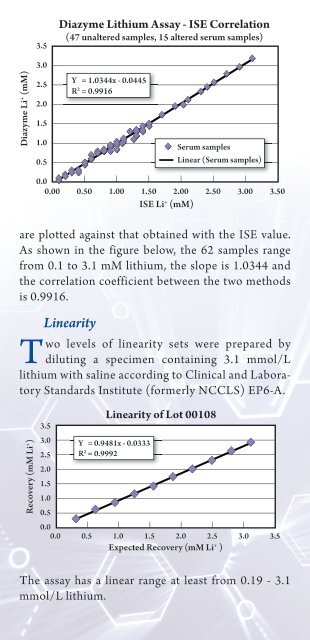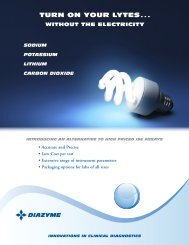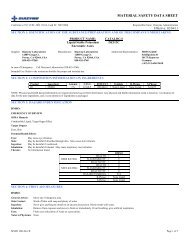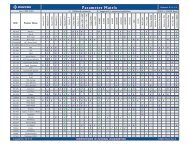Lithium test - Diazyme Laboratories
Lithium test - Diazyme Laboratories
Lithium test - Diazyme Laboratories
Create successful ePaper yourself
Turn your PDF publications into a flip-book with our unique Google optimized e-Paper software.
<strong>Diazyme</strong> Li + (mM)<br />
3.5<br />
3.0<br />
2.5<br />
2.0<br />
1.5<br />
1.0<br />
0.5<br />
<strong>Diazyme</strong> <strong>Lithium</strong> Assay - ISE Correlation<br />
(47 unaltered samples, 15 altered serum samples)<br />
Y = 1.0344x - 0.0445<br />
R 2 = 0.9916<br />
Serum samples<br />
Linear (Serum samples)<br />
ISE Li + 0.50 1.00 1.50 2.00 2.50 3.00 3.50<br />
(mM)<br />
are plotted against that obtained with the ISE value.<br />
As shown in the figure below, the 62 samples range<br />
from 0.1 to 3.1 mM lithium, the slope is 1.0344 and<br />
the correlation coefficient between the two methods<br />
is 0.9916.<br />
Linearity<br />
Two levels of linearity sets were prepared by<br />
diluting a specimen containing 3.1 mmol/L<br />
lithium with saline according to Clinical and Laboratory<br />
Standards Institute (formerly NCCLS) EP6-A.<br />
Recovery (mM Li + )<br />
0.0<br />
0.00<br />
3.5<br />
3.0<br />
2.5<br />
2.0<br />
1.5<br />
1.0<br />
0.5<br />
0.0<br />
0.0<br />
Linearity of Lot 00108<br />
Y = 0.9481x - 0.0333<br />
R 2 = 0.9992<br />
Expected Recovery (mM Li + 0.5 1.0 1.5 2.0 2.5 3.0 3.5<br />
)<br />
The assay has a linear range at least from 0.19 - 3.1<br />
mmol/L lithium.<br />
Lab <strong>test</strong>ing for blood<br />
lithium using automated<br />
chemistry analyzers<br />
Blood drawing for<br />
lithium level monitoring<br />
Interference<br />
To determine the level of interference from the<br />
substances normally present in the serum,<br />
<strong>Diazyme</strong>’s Liquid Stable Enzymatic <strong>Lithium</strong> Assay<br />
was <strong>test</strong>ed with 1.0 mmol/L and 2.5 mmol/L lithium<br />
serum samples spiked with various concentrations of<br />
substances following Clinical and Laboratory Standards<br />
Institute (formerly NCCLS) EP7-A “Interference<br />
Testing in Clinical Chemistry”: dose-response<br />
guidelines.<br />
Result: The following substances normally present in<br />
the serum produced less than 10% deviation when <strong>test</strong>ed<br />
at levels equal to the concentrations listed below.<br />
Interference Concentration<br />
Ascorbic Acid 5 mmol/L<br />
Bilirubin 45 mg / dL<br />
Bilirubin Conjugate 20 mg/dL<br />
Hemoglobin 500 mg / dL<br />
Triglyceride 1000 mg / dL








